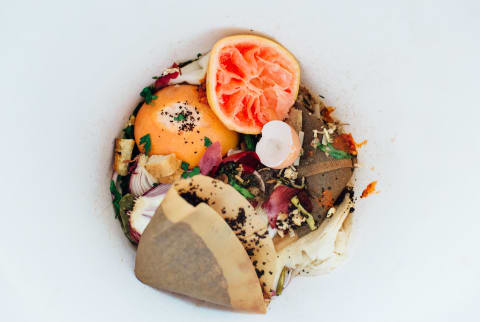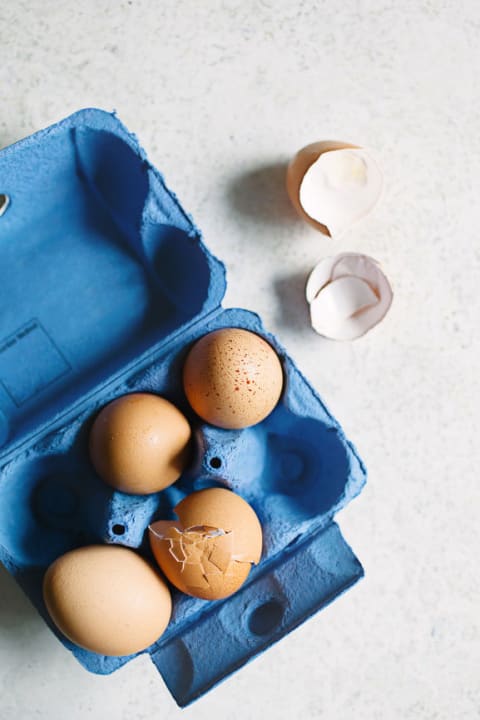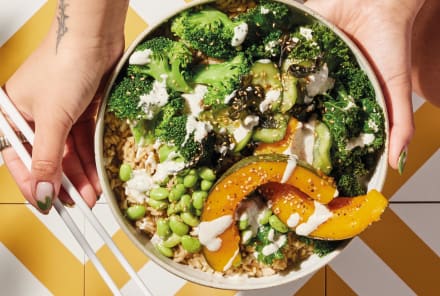Advertisement
Composting At Home Doesn't Have To Be Hard (Or Smelly), Thanks To This Painless Guide


This year, there's been a lot of talk about the importance of beating plastic pollution so it doesn't end up in our oceans. And it’s about time. But there’s another complex waste stream we interact with every day that deserves our attention: organic waste.
The term organic waste refers to all of our food waste, yard clippings, and un-recyclable paper products like used tissues, paper towels, paper plates, and cardboard scraps. Many of us toss these things without even thinking about it: We wipe the scraps off our plates, trash our spoiled fruit, and throw out mounds of many paper towels used to clean up messes.
Long thought to naturally break down when thrown in the trash, we now know that these organics not only linger in landfills but release greenhouse gases that contaminate the environment as they (very slowly) break down. Composting steers materials away from this wasteful fate and turns them into something valuable: nutrient-rich soil conditioner that can fortify planters, gardens, and farms.
As an individual looking for new ways to offset your carbon footprint, composting is one of the best things you can do for the environment—and you don’t need to have a backyard to do it.
How difficult is it to compost at home?
I know what you’re thinking: "What about the smell?" or "Won’t my house be swarmed with fruit flies if I start composting?" As long as you have a system that works for your space, the answer is no.
Here's your step-by-step guide to composting your waste and creating top-of-the-line organic fertilizer from the comfort of your own home while keeping the bugs away and the smell at bay.
Start with the right base.
Step one is buying a compost bin, and you should be able to find one at any gardening supply or hardware store. If you’re on a budget, trash cans or large buckets with lids work in a pinch. And if you're pressed for space, you can keep a small container on your countertop for scraps that you would have otherwise tossed; Target stocks a colorful ceramic one that comes with a charcoal filter to help absorb odors.
Once you have your container, pick up a compost thermometer to monitor the temperature of your bin. Compost heaps need steady conditions, and thankfully, indoor bins have a year-round temperature of between 40 and 80 degrees. Outdoor bins and piles, on the other hand, need to be shielded from the elements (extreme hot and cold, and rain and snow), which can prevent decomposition and grow weeds and parasites.
Then, creating proper aeration and air flow is a key to reducing odor accumulation and helping good bacteria do its thing. Many composting bins have holes for this purpose, but you can drill holes on the bottom and sides of yours if they don't. Place a drainage tray underneath to allow some material and moisture to get out.
Add your ingredients.
Compost piles are like the human body: The more you feed them good stuff, and a variety of it, the healthier they will be. But much like modern life offers us processed, chemical-laden, difficult-to-digest snacks, there are many common household waste items available that pose a health risk when added to compost.
Let’s start with what you should put in. First, line the bottom of your bin with potting soil from your local gardening store or even soil from outside. This will serve as drainage, give a solid foundation, and add nutrients and microorganisms to kick-start your batch.
The two main categories of scraps that you throw into your compost bin from there are known as "greens" and "browns." "Greens" are things such as fruit and vegetable scraps (including corn husks and banana peels), coffee grounds, and yard clippings. These are rich in nitrogen and allow microorganisms in your compost to make protein and reproduce.
"Browns" are the carbon-rich, typically dry materials that provide working microorganisms with a source of energy. Paper towels, tissue and toilet paper, paper shreds, coffee filters, and cardboard are all browns. These will also help keep smells to a minimum and bugs away. Just take care to tear up your paper egg cartons and newspapers, as whole pieces will take much longer to break down.
Generally, you'll want to avoid all animal by-products (meat scraps, dairy, grease and lard) and any synthetics. "Greens" and "browns" contaminated with these items, such as greasy pizza boxes and napkins, yard trimmings treated with pesticides, or glossy paper, are also out.
And no plastics, obviously—even the ones labeled "biodegradable" or "compostable." These need a specialized, industrial composting facility with extremely high temperatures and a controlled biome and won't break down in a home compost bin, indoor or outdoor.
So how do I get compost from these "greens" and "browns"?

There is a natural order to things, and layering greens and browns correctly will provide the best results and reduce smells. Start with your foundation of potting soil, and mix with shredded paper for filler. Then, start to build alternating layers of "greens" and "browns" on top. It's a general rule of thumb to add one part "greens" to every two parts "browns." If your bin starts to get smelly, try adding three parts browns. Mitigate smells and keep away fruit flies by continuously checking in and maintaining your layers.
Water is essential to all life, and compost is sort of a living thing, so dampening your compost bin is also crucial. You can pre-dampen your browns by using slightly wet cardboard or newspaper, but make sure your compost bin is only damp, not soaking wet.
Once a week, be sure to take some sort of gardening spade or small shovel and mix up the components of your bin's layers. This keeps the layers from reacting with one another and ensures that air flows to every part of your pile, which helps the bacteria break down the scraps.
And that’s basically it! If you like, you can add a little something extra to supplement your soil supplement and supercharge it or make it break down faster—plants love odd things like human or pet hair that break down into nitrogen. And if you're feeling adventurous, worms are also right at home in a compost bin. They turn organic waste into fluffy, dark fertilizer through a process called vermicomposting.
Eliminating the idea of (organic) waste.
Once you’ve got this down, you should have some rich and healthy soil in a few months or less, depending on the size of your heap. So have fun and spread the word of composting in your community. Show your friends and family just how easy it is to reduce waste and create a rich fertilizer you can eventually use to grow your own foods and plants.
If home composting isn’t your thing, another way to reduce organic waste is to find your nearest composting facility, or a retail location that offers composting, and save your organics for drop-off. At TerraCycle's HQ, we have a compost pick-up, so my colleagues have been known to bring their compost to work from home, even on the train! Pro tip: Put your organics in empty yogurt tubs or salad containers and put them in the freezer to prevent smells and mess.
At the end of the day, remember that changing your consumption patterns is the very best way to reduce your footprint. Buy only what you need, cook food you know you'll eat, and support local food systems to stay connected with what's on your plate.
Next up: Check out this legendary environmentalist's advice for cutting down on your food waste.
Watch Next
Enjoy some of our favorite clips from classes
Enjoy some of our favorite clips from classes
What Is Meditation?
Mindfulness/Spirituality | Light Watkins
Box Breathing
Mindfulness/Spirituality | Gwen Dittmar
What Breathwork Can Address
Mindfulness/Spirituality | Gwen Dittmar
The 8 Limbs of Yoga - What is Asana?
Yoga | Caley Alyssa
Two Standing Postures to Open Up Tight Hips
Yoga | Caley Alyssa
How Plants Can Optimize Athletic Performance
Nutrition | Rich Roll
What to Eat Before a Workout
Nutrition | Rich Roll
How Ayurveda Helps Us Navigate Modern Life
Nutrition | Sahara Rose
Messages About Love & Relationships
Love & Relationships | Esther Perel
Love Languages
Love & Relationships | Esther Perel











